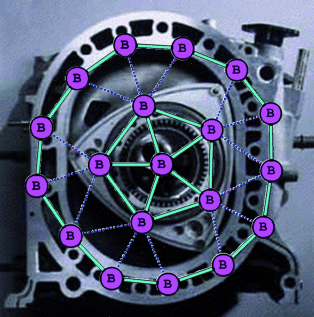
RESEARCH INTERESTS
Reaction Mechanisms of Organic and Organometallic Reactions (Homogeneous Catalysis)

Since I was a child, I was intrigued about the way the molecules collide each other and combine themselves assembling a new structure, with different chemical (and physical) properties. My first touch, when I was twelve, was when my father took me to a Lab of Organic Chemistry. There, I was questioned about predicting which color would be resulting when mixing two different colored chemical solutions. I thought it would follow the mixing color rule (red plus yellow gives orange, blue and yellow give green, etc.) but it was not, instead pallid red and blue could give, for instance, a transparent color solution plus a precipitate. So, many years later after learning about color changes, I got in love with reaction mechanisms. It is like solving a puzzle. Reaction mechanisms require creativity, imagination, and of course, chemical intuition, that is part of the challenge; the other side is that every chemistry can have a very different reaction mechanism. There are no limits for proposing new transition states when investigating a chemical reaction. Periodic table is like a chess table: different openings and combining, let’s say, 105 elements in different ways is never ending. Of course, we try to propose the best reaction path but we know we are not infallible; we get a lot of fun in doing so.
Representative Publications:


Studies of Electronic Structure of Compounds Showing New Chemical Bonds
We are interested on the computational investigation of compounds synthesized by our experimental colleagues especially in those containing a chemical bond between two atoms that meet together for the first time. And, in the quantum world, governed by the wave function, we can explore a finite but very large number of conformations on the potential energy surface computationally in order to predict the more feasible structure to exist in the real world (without taking into account that our computational methodologies and models are far away of simulating real conditions at all). Therefore, experiment is the most valuable thing a theoretician can take. So, we want to help to characterize better a new compound by analyzing its electronic structure by applying our computational techniques.
Representative Publications:


Reactivity of Molecules containing Block-p Elements
Chemistry is a science about all of the possible combinations of elements. Its origin from alchemy and the ultimate aim, superstitious or not, were for controlling nature in our quest looking for the unity to all. Then, this world full of concepts makes us enter into paradoxes and rules that are not immutable laws. Not so many years ago, we thought about Organic Chemistry (C, H, O, N, S chemistry and relates) as our fundamental pillar in all Chemistry, a general box where we put all the other elements and we believed transition metals are the richer ones for doing Catalysis (and the rest beyond were rare earth elements (rare) or inactive noble gases. We, chemists in the world, are now doing a step forward accepting that was a good start but not an eternal true. Therefore, our group has turned to the chemistry of block-p elements, which under certain circumstances, can act as transition metals (in the sense, they also can do some catalysis). Boron chemistry is one of the most representative examples.
Representative Publications:
Inorganic Clusters and Aromaticity


What makes a ligand the more suitable for a chemical reaction to proceed? Here, our intention is the design of new ligands, especially for Organometallic Chemistry, and enrich even more the variety of them that is already known by means of computational research. As usual, we are pursuing the goal of tuning the reactivity of a complex by making some modifications to the original structure of a ligand. We are working with different sets of inorganic clusters and one typical phenomenon found on them is the aromaticity. Again, as other concepts in Chemistry, aromaticity had had a diffuse interpretation and now, by realizing that this a multidimensional property, many colleagues have been contributing in showing this and other peculiarities for measuring stability of a molecule in terms of its structural, energetic, magnetic and electronic properties. We also want to keep working on the classification and depuration of this key concept in Chemistry.
Representative Publications: